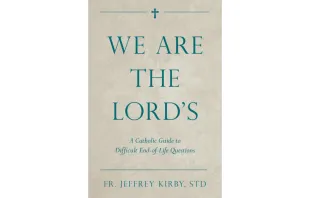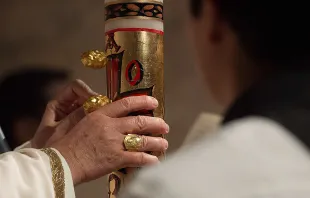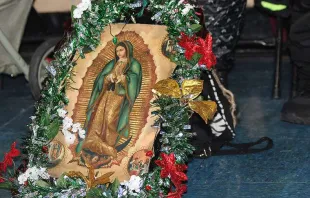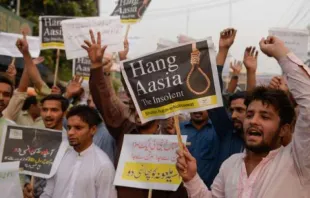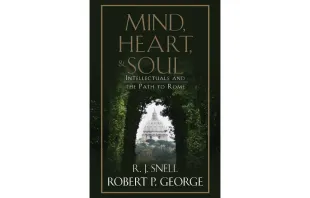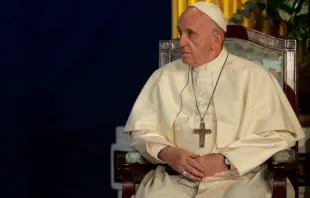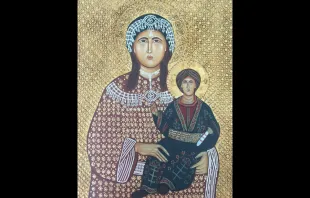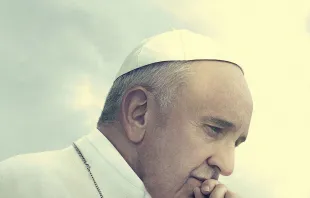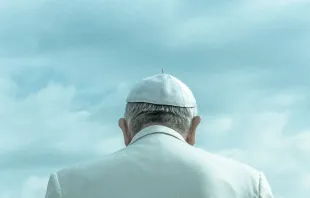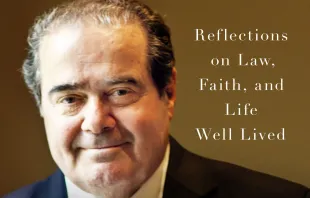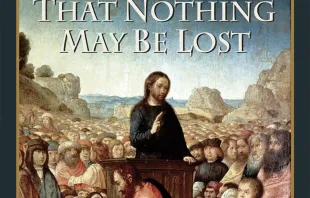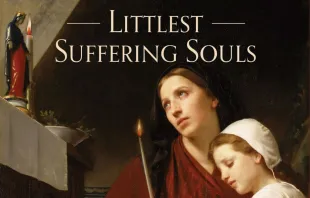Articles by Andrea Picciotti-Bayer
A loving big brother during coronavirus
Apr 8, 2020 / 00:00 amMy youngest son Patrick turns four this week. He is a delight to watch at this age, particularly when one of his older brothers carries him around the house. Facing the uncertainty of the COVID-19 pandemic, I’ve longed for the joy and confidence that Patrick exudes when he’s in their strong arms. The other day, I was reminded of a group that Saint John Paul II once called the “Strong Right Arm” of the Catholic Church – The Knights of Columbus. The two-million-member Catholic fraternal organization is flexing that “strong right arm” in the response to the COVID-19. The order’s new “Leave No Neighbor Behind” initiative is helping local members address the pandemic’s unique challenges in tangible and intangible ways. “[O]ur duty is to lead our families, protect our parishes, and serve our communities, remembering always that where there’s a need, there’s a Knight.” In addition to encouraging members to donate to, and volunteer at, local food banks, the Knights of Columbus are also encouraging members to donate blood. The latter is a longstanding tradition of the order. In fact, the Knights of Columbus pioneered nationwide blood drives in the United States in the 1930s. But the “Leave No Neighbor Behind” initiative doesn’t end there, because the Knights understand that the challenges will remain long after the medical crisis abates. Whether it’s a matter of weeks or months, the stay-at-home orders will eventually be lifted and school, work, social and worship routines will resume. But the economic toll of the public closure of parishes will likely be felt long after parish churches reopen for Sunday mass. Fortunately, the Knights are offering financial support to struggling Catholic dioceses across the United States. The order just announced it has available $100 million in low-interest financing to help dioceses weather the economic impact of COVID-19 crisis. The Knight’s financial assistance program isn’t new; the order has been a key lender to parishes and dioceses for more than a century through its ChurchLoan program. The magnitude of the available assistance is. This financial safety net will allow Catholic parishes to continue to serve bodies and souls during and in the aftermath of this epidemic. In fact, none of this is new for the Knights of Columbus. They’ve been responding to crises, individual and societal, since their founding in the late 1800s. Started by an Irish-American Catholic priest (Father Michael J. McGivney) and named in honor of the great Italian explorer (Christopher Columbus), the Knights began as an organization to care for widows and orphans from St. Mary’s parish in New Haven, Connecticut. Today the Order is organized into more than 15,000 local councils based in cities and towns across the country and abroad. Dedicated to the principles of charity, unity, fraternity and patriotism, the Knights participate in educational, charitable, religious, social welfare, war relief and public relief works. The Knights have a long history of community outreach through innovative charitable programs. “During times of need from the 19th century to the present, the Knights of Columbus has been there in communities around the country to support one another, the Church and the evolving needs of their communities,” says Supreme Knight Carl Anderson. “From world wars, to influenza pandemics more than a century ago, to hurricanes and earthquakes, the Knights of Columbus has helped make the difference for many individuals and communities, and we will do so again during the present situation.” Today’s Knights of Columbus constitute a vast volunteer network of members ready and willing to ensure that essential needs are met in communities from coast to coast. Members are assisting one another, especially the elderly and those living alone. At a time when many churches are closed, the Knights are reaching out to their fellow parishioners and pastors to identify and meet local needs as they arise. Finally, the Knights of Columbus as an organization has kept its focus on the importance of placing our trust in God. It is providing spiritual resources to its members and urging them to offer prayers composed by Pope Francis and the U.S. Conference of Catholic Bishops during this time. Once again, in a time of crisis, the Knights of Columbus has risen to the occasion to serve both neighbor and Church with the strong arms of a loving big brother.
Book Review: We are the Lord's
Dec 18, 2019 / 00:00 amTwo years ago, I joined a Catholic women’s symposium that discusses the weighty matters affecting our Church and our culture. One member of our group recently told us that her elderly father was in his last days. She asked for prayers and any resources we might have to guide her and her siblings and mother in navigating weighty end-of-life issues she expected they would face. There was a flurry of supportive responses and commitments to pray, but it took a while before anyone could forward along any helpful material. For my part, I knew of nothing to suggest off-hand. I won’t face this problem again, thanks to Father Jeffrey Kirby’s We are the Lord’s: A Catholic Guide to Difficult End-of-Life Questions. A copy of this excellent, straight-forward end-of-life book arrived in the mail a few weeks ago, though, alas, a few days after my colleague’s father passed away (a “happy death” with family around, she relayed) and the email thread ended. Kirby sets forth basic principles of discernment for answering some of the hardest – and most common – questions surrounding end-of-life medical care and treatment. He also addresses the challenging practical issues that face the dying and their family members at this time. Father Kirby begins by confronting the great modern misunderstanding of the human condition and dying. “No person is a burden,” he writes. Yes, this may seem obvious to so many us, but it’s no less important a truth, because we live in a culture that is “intoxicated with utilitarianism” – the notion that “any inconvenience for another person, or any service that makes us uncomfortable, is unmerited.” Christian teaching, however, has “always asserted that the only response to a person is love.” Loving the dying – seeking their good, delighting in them – exposes, Kirby argues, the “selfishness that disguises as compassion.” For children of God, Kirby reminds us, “quality of life” is “matured by love and an openness to live with inconvenience, discomfort, imperfection and suffering.” Kirby outlines three important principles of discernment to guide bioethical and end-of-life decisions. One, we must recognize God as our Creator and accept the existence of an objective order of moral truth that is beyond us. “Our personal will, or desire for autonomy, are not sovereign,” he writes. “These must be placed within our human dignity and the objective order of moral goodness.” Two, we must understand our particular vocation. That is, we have to consider our duties and responsibilities toward others, our talents and capabilities, as well as the state of our souls. Three, we must appreciate the difference between what is morally obligatory (ordinary care, in the medical context) and what is morally optional (extraordinary care). My own parents recently told me that they have “all of their affairs in order.” One such affair is the advanced directive, a summary of a person’s wishes in various medical situations. Father Kirby notes, however, that while such planning is prudent, it does not completely resolve end-of-life questions. As bioethicists often say, “When you have one situation, you have one situation.” Advanced directives, therefore, must always should be understood as guidelines and, most importantly, never can betray moral truths in light of the unique set of circumstances a person faces. On a most practical level, We are the Lord’s includes a chapter that addresses specific medical questions. It’s a quick reference for readers facing urgent decisions. One common medical concern, for instance, is the continued provision of nutrition and hydration. Kirby is unequivocal in explaining that unless a person’s body cannot assimilate them or it becomes harmful, at no point should a sick person be denied food or water. The overarching lesson of We are the Lord’s is to abide, and encourage our loved ones to abide, in a spirit of abandonment to the will of God. In living. And dying. The book’s title – coming, as it does, from Saint Paul’s letter to the Romans —reminds us how end-of-life decisions for ourselves or others should be faced: “For if we live, we live for the Lord, and if we die, we die for the Lord; so then, whether we live or die, we are the Lord’s.” I’d not only recommend reading We are the Lord’s, I’d also suggest having a copy or two of Father Jeffrey Kirk’s handy guide available for the next time a friend, family member or colleague faces an end-of-life issue.
Book Review: A Year with the Mystics
Oct 11, 2019 / 00:00 amOur parish’s fall festival was coming to an end. As I rounded up my little ones, I spotted an acquaintance. Antoinette is almost 95 years old and now wheelchair bound, but her incandescent smile inevitably draws people towards her. “Have you had a nice evening?” I asked. “Oh yes,” she replied, “I spoke for a long time with Father.” “You know,” I said in a hushed tone, “I think he is a mystic.” “Yes,” Antoinette said, taking a deep breath, “he saw right to my soul.” A mystic is not some sort of Catholic tarot card reader. A mystic is, in the eyes of traditional Christianity, someone God has given certain gifts and graces to accomplish a specific purpose for the salvation of souls. Some of the Church’s notable mystics include great saints like St. Padre Pio, St. John of the Cross, St. Teresa of Avila and St. Catherine of Siena. Their extraordinary ability to sense God transformed their hearts. Theirs were hearts moved to quiet and solitude when necessary, but also to action and service to souls and the Church. They were obedient to God and Church, and – not unrelatedly – they were profoundly humble. Now, we shouldn’t think that the exceptional relationship that mystics had with God is just for an elite, holy few. No, not at all. Mystics walk among us in our everyday lives – Antoinette’s and my parish priest, for example – and a mystical relationship with God is open to us all. In fact, God longs to connect with each one of our hearts and transform them for His glory. To that end, National Review’s Kathryn Jean Lopez has just compiled a beautiful daily devotional, A Year with the Mystics: Visionary Wisdom for Daily Living, that can help open our hearts to such prayerful, mystical encounters with God. Lopez’ message is simple: “You too can be a mystic.” “I don’t pretend to either be a mystic or an expert on mysticism,” she writes. “But I do pray enough to know that so very few us of us have plumbed the depths of what God wants to reveal to us and do in us through prayer.” A Year with the Mystics features brief, daily meditations grounded in the writings and prayers of the Catholic Church’s well-known mystics – Padre Pio, Teresa of Avila, and John of the Cross, for example. Lopez also includes the words of “active saints in the world,” figures not conventionally thought of as mystics such as Mother Teresa and Mother Angelica. The book is not a formulaic, chapter-by-chapter guide to the interior life. Rather, each day’s reflection invites the reader into a particular contemplation. “Entering into the light,” “Divine friendship,” “Looking in the mirror, seeing light and virtue,” “Pray without ceasing? A how-to” are some of my most favorite daily invitations. Lopez follows up with a brief introduction to an inspired writing, the excerpt itself, a consideration and then a final prayer. The reading and daily meditation takes a brief 15 minutes, but it can inspire an entire holy hour or direct your entire day. It’s worth pointing out that the book is beautifully bound and sturdy enough to survive transport in a purse, briefcase, or the door pocket of the car so that not one day of contemplation is missed. I have turned to this little volume often in my prayers since receiving my review copy. And I have found great consolation – the kind of consolation I saw on Antoinette’s smiling face after she spoke with Father John at the parish festival. For most of us, the mystical union with God will be found as contemplatives in an often loud and busy world. Inviting the mystics to accompany us along our journey of contemplation presents an opportunity for incredible growth in our prayerful encounter with God. In A Year with the Mystics, Kathryn Jean Lopez has mapped a lovely and useful path to facilitate this encounter. “Be not afraid as you’ve heard and will read,” she writes “Let him bring you to a peace that surpasses all understanding, even as he brings you into a deeper understanding in the heart of the Trinity.”
'Be still and know that I am God'
Apr 16, 2019 / 00:00 amHow many Catholics will fill the pews on Easter Sunday 2019? Will this year see a noticeable decline in parishioners dressed in their Easter finest? Will the past year’s “Summer of Shame” – the publication of the Pennsylvania grand jury report, the (now-defrocked) Cardinal Theodore McCarrick scandal, the Vatican’s tepid, tone-deaf response to abuse here and elsewhere in the world – take its toll on the Catholic Church in America this Easter? Some Catholics have already left the Church. Quite publicly. Others have not yet taken that step; they’re simply shaken and disaffected. This is not one of those stories. I remain convinced that the Catholic Church is where I should be. Of course, I was angry when the findings of the Pennsylvania grand jury on clerical sexual abuse of children became public last August. How could men entrusted with the care of souls egregiously harm innocent children? News of Theodore McCarrick’s most unholy life also disgusted me, especially the news that more than a few people knew that this high-ranking American prelate had preyed on people and said nothing. All in all, I felt betrayed and humiliated. I have found some consolation since those first months of shock, confusion and revulsion. Peter Steinfels’ excellent analysis of the grand jury report in Commonweal Magazine helped. He showed that almost all the abuse cited took place decades before the U.S. Catholic bishops’ 2002 steps to protect minors. These reforms have made Catholic churches and schools among the safest places for children in the United States. Then, this past February, Pope Francis finally defrocked McCarrick and hosted a world summit on clergy abuse. There is still much more to do to restore the priesthood and episcopate. Some members of the hierarchy here and in the Vatican appear genuinely concerned and are working to rid the rot that has seeped into the Church. Is it only window-dressing? Only time will tell. What are average Catholics to do in the meantime? This Lent, I found my answer in Psalm 46:10: “Be still and know that I am God!” It is easy to walk away when things get difficult. Pointing to the failings of others on your way out may even offer a gratifying sense of self-righteousness. Instead of leaving the Church, however, I am choosing to be still. The Catholic Church is where I belong, despite the failings of many of her faithful, including yours truly. Living as a faithful Catholic is not convenient or comfortable or popular today. It never has been. Ask the first pope, Saint Peter, who was crucified upside down. Or other martyrs to the faith of our past or present. Say the 21 Coptic Christians kidnapped and beheaded in Libya in 2015. Yes, U.S. Catholics today face a crisis – our summer and winter and spring of shame, the failure of some priests and prelates, not to mention the Church and Her faithful’s place in an increasingly hostile secular culture. While today’s crisis pales in comparison to crises other Christians have faced over the millennia, it has led many to bouts of despondency. I am surely no exception. But when I am “still” – when I trust that God has put the Church in charge of my spiritual well-being and try to follow Her teachings – I can handle whatever contradictions and confusions that the all-too-human leaders of the Church send my way. Or the challenges everyday life bring. Loss, suffering, humiliations or just plain exhaustion can’t keep me down for long. Instead of letting the scandal of sexual infidelity by a handful of priests and bishops dissolve this trust, I have resolved to be still and live more faithfully. What does that look like? It means embracing all that the Church teaches, turning to Her sacraments, and doing so joyfully. It means being a light for others. As Saint Augustine said, “The measure of love is to love without measure.” No, now is not the time to leave. Now is the time to stand confidently in defense of the Church’s eternal teachings. Now, today, this moment is the time to show it is possible to live consistent with Catholic teaching and desire the good of all around me. So, as Easter season draws near with its promise of immense joy, I will be still, unwavering in my fidelity to a church that calls me to be a faithful, joyous messenger of love and hope. “Be still and know that I am God!”
Book Review: The Anti-Mary Exposed
Mar 28, 2019 / 00:00 amWhy are so many women so angry today? Don’t get me wrong, confronting abuse, harassment, and unfair treatment demands a certain toughness and righteous anger. But more than the injustices of the day seem to be making women really angry. Dr. Carrie Gress’ thought-provoking new book, The Anti-Mary Exposed: Rescuing the Culture from Toxic Femininity, offers a convincing explanation: We live in an age of the Anti-Mary. It is well-accepted, at least in Catholic circles, that Mary brought a unique spirit into the world as the Mother of God. She is the anti-Eve, the New Eve. Gress builds upon this understanding and argues that “[i]f Christ is the New Adam and Mary the New Eve, it makes sense to consider that an antichrist could have a female complement.” This complement is an anti-Marian spirit that “animates an entire movement and the individuals engaged in it.” That movement is what passes for feminism today. What does this “anti-Marian spirit” look like? [A] woman in its grip would not value children. She would be bawdy, vulgar, and angry. She would rage against the idea of anything resembling humble obedience or self-sacrifice for others. She would be petulant, shallow, catty and over sensuous. She would also be self-absorbed, manipulative, gossipy, anxious, and self-servingly ambitious. In short, she would be everything that Mary is not. She would bristle especially at the idea of being a virgin or a mother. The description is bracing and familiar. I know this spirit. At my best, I struggle against it. At my worst, I am overtaken by aspects of it. We probably all are, women and men, as individuals. Gress, however, is arguing that this unattractive “anti-Marian spirit” has become something of a spirit of the age for far too many women today. The result is a prevailing anger. And a prevailing discontent. Gress finds the roots of the anti-Marian spirit in the early feminist movement of the 1960s. She recounts the movement's founding and the dramatic influence it has had on how women think about themselves today. Her history lesson is not glamorous. It is not chic. It is downright ugly and reveals how "feminism" from its infancy indulged in the vice of envy. Today, proponents of unfettered abortion have taken up the baton once carried by early radical feminists. They peddle the idea that a woman's developing child is a threat to her advancement, success, and happiness. Adherents of a toxic feminism do not “embrace the goodness that men have to offer society but view it as an evil that must be eliminated.” This anti-Marian spirit has rebranded and exalted as role models the “woman of folly,” Jezebel, and Lilith – characters referred to in cautionary tales found in Scripture and literature. Women under the spirit’s grip embrace the Marxist idea that divorces motherhood from the reality of being a woman. While rejecting the general idea of “goodness,” slaves of the anti-Marian spirit are encouraged to "find the goddess within." Fortunately, Gress’ The Anti-Mary Exposed is not mere commentary on our ailing culture. Rather, it is a self-help book for rescuing womanhood. So, what can modern woman do? How can we pull ourselves away from the “anti-Marian spirit” before being completely consumed? The antidote Dr. Gress prescribes is Mary -- our perfect model of Christian femininity. In Mary, we find a woman, not a goddess. She is sinless and perfect. She is not enslaved by vice. Her power is in her complete surrender to God. Mary’s meekness does not make her a doormat. As Saint Pope John Paul II observed, Mary “participated maternally in the tough fight against the powers of darkness that unfold during the whole of human history.” In short, she fights like a mom. The desires of women's hearts, Gress observes, "are to be beautiful, to be fruitful, to have their dignity respected, and most essentially, to be known and loved." Imitating Mary -- the perfect model of one who is "loved by God and who has an authentic relationship with Him" -- will satisfy these desires. The Anti-Mary Exposed: Rescuing the Culture from Toxic Femininity is a powerful read. Gress cogently explores how radical feminism has unleashed a malicious "anti-Marian spirit," but leaves women and our culture a way out. Our embrace and imitation of Mary can rescue our culture, our womanhood. As Gress makes clear in this gem of a book, "[Mary] offers us the key to unlock the confusion about what it means to be women and what we need to do to find the true happiness that our souls crave."
Can Asia Bibi remain acquitted of blasphemy in Pakistan?
Jan 28, 2019 / 00:00 amThis Tuesday a three-judge panel of Pakistan’s Supreme Court will decide whether to reconsider its acquittal of a Pakistani Christian mother-of-five on charges of blasphemy. Yes, you read that right. One of our allies in the fight against terror may be having second thoughts on whether a middle-aged mother-of-five deserves to be put to death for defending herself and her faith. Asia Bibi is a Christian, a Roman Catholic to be precise, who lived in Pakistan’s predominantly Muslim province of Punjab. This peasant woman worked in a berry field to help her husband support their children. Asia’s status as a religious minority was not a “protected” one. Far from it. She suffered constant insults from neighbors, even though they, too, shared in the same suffering that comes with extreme poverty. One day, while working in that berry field, Asia went to the well for some water. She drank from the common cup available to those working the land. In that moment — in that simple human act of relieving one’s thirst—a series of dreadful events unfolded. A co-worker in the berry field confronted her and said that Asia —a Christian —could not drink from the same cup as the other Muslims. Asia was “unclean.” Asia spoke her mind. She defended her faith. Later that day neighbors beat Asia when she returned home. Her persecutors claimed Asia confessed to having uttered derogatory remarks about the prophet Muhammad when confronted at the well in the berry field. And the next day the local cleric, Qari Muhammad Salaam, filed a complaint against Asia. Asia was charged and convicted of blasphemy in 2010. In Pakistan, a blasphemy conviction carries a mandatory death sentence. The local authorities sentenced her to death by hanging. Asia languished in prison for more than eight years. Prison officials gave her food to cook, knowing that she would likely be poisoned if she ate with the general prison population. They also placed her in solitary confinement and limited her contact with anyone outside of her immediate family. The years of imprisonment must surely have taken their toll. Most Pakistanis accused of blasphemy don’t live long. Mob rule executes the death sentence long before the government has the chance to do so. In last year’s annual report, the U.S. Commission on International Freedom once again recommended Pakistan be identified as “a country of particular concern.” It specifically mentioned Asia as an example of the “continued misuse [of blasphemy laws] against religious minorities and progressive Muslims.” Secretary of State Mike Pompeo heeded the Commission’s advice and listed Pakistan among those countries guilty of severe religious freedom violations. Nevertheless, last October a three-judge panel of the Pakistani Supreme Court overturned Asia’s conviction. It said that the prosecution had “categorically failed to prove its case beyond a reasonable doubt.” Not only that, but the case was based on flimsy evidence and proper procedures had not been followed. The panel pointed out that Asia’s alleged confession had been made in front of a crowd “threatening to kill her.” Asia Bibi was, it seemed, free at last … … but her freedom proved fleeting. Qari Muhammad Salaam, the local cleric who brought the complaint against Asia, demanded she be prevented from leaving Pakistan and led widespread protests of the ruling. He also filed a petition for reconsideration by Pakistan’s Supreme Court. Salaam argued that the Supreme Court panel failed to meet the standards of jurisprudence or Islamic law and the "normal principle of justice with reference to application in blasphemy laws.” Well aware that some of their countrymen are violently intolerant of Pakistan’s religious minorities, the three judges will decide Tuesday whether to defend their October 2018 acquittal or back away from it. It’s a moment for Pakistan, but for the United States and the rest of the civilized world, too. In one of our allies in the war on terror, the rule of law and religious freedom, to say nothing of a mother-of-five’s life, hang in the balance. Will the story of Asia Bibi end in her freedom or martyrdom?
Book Review: Mind, Heart, & Soul
Nov 27, 2018 / 00:00 amThe Catholic Church in the United States has received staggering blows of late. The sinful and criminal behavior of a former leading prelate, the statewide investigations into clergy sex abuse across the country, the Vatican’s confused and vapid response – all have left many of the faithful in despair. Some American Catholics are even questioning their fidelity to Mother Church. It may seem curious, therefore, that comes now a new book recounting the conversion stories of sixteen leading intellectuals. Of course, there are no coincidences in the often-charming world of God. In Mind, Heart, & Soul: Intellectuals and the Path to Rome, Robert George and R.J. Snell offer a refreshing and inspirational reminder from some of today’s greatest minds of the many splendored reasons to be Catholic. Professors George and Snell preface their work with this simple observation: “Every Catholic is a convert.” As explained in the Catechism of the Catholic Church, “we are freed from sin and reborn as sons of God; we become members of Christ, are incorporated into the Church and made sharers in her mission” through baptism – whether as babies or adults. Nevertheless, as George and Snell aptly note, there is something fascinating about adult converts to Catholicism. “For many, although certainly not all, converts entering the Catholic Church as adults, whether from another Christian community, another religion, or no faith at all,” they write, “the Catholic intellectual tradition was experienced as part of the struggle to come home.” The sixteen interviews in Mind, Heart, & Soul were completed before the Church’s “summer of shame.” Neither former-Cardinal Theodore McCarrick’s horrific behavior or the Pennsylvania grand jury’s report on clergy sexual abuse had become public. Yet, as George and Snell observe in their preface, these conversion stories are “signs that while we do not place our trust in princes (Ps. 146:3), we continue to trust in a God who does not abandon us and who, in the words of one Eucharistic prayer, will ‘never cease to gather a people to [Himself], so that from the rising of the sun to its setting a pure sacrifice may be offered to [His] name.” The converts, as well as those who interviewed them, are an impressive lot. They include leading theologians, university professors, scholars, journalists, writers, and a current U.S. bishop. Some are acquaintances. One I consider a friend. Each “conversion story” is as unique as the soul that owns it. Readers are invited to contemplate the spiritual truths that prompted these intellectuals to find their way to the Church. Dominican Father Thomas Joseph White grew up in southeast Georgia as the only child of a Jewish father and a Presbyterian mother. He has taken up the task of reintroducing Thomistic thought to an ever-growing secular world. He advises pilgrims, old and new, to engage with God “on God’s terms and according to the Church’s teachings.” For all believers searching for the truth, “[t]he real answer is to enter the Catholic Church and live the sacramental life, and not despair in the search for the truth, because God is always very close to us and will give us the means to arrive at the destination if we want him to do so.” Similarly, Harvard Law Professor Adrian Vermeule matter-of-factly remarks that “the depths of the Church are not disturbed by the storms that pass to and fro on the surface.” Rather, he says , “the Church seems to me an institution whose foundations are as strong as iron. The turmoil will pass away; episodes, scandals and debates will come and go; but the line and witness of Peter’s successors will never fail.” And my dear friend Hadley Arkes, one of the country’s foremost experts on natural law, remarks that “the Church was and is the main refuge for sanity.” Arkes’s odds-on assertion: “[W]hen the Church stands contra mundum, against the currents of moral opinion on any issue, my betting is that the Church has it right.” It’s important to point out that Mind, Heart, & Soul is no dry recitation of the intellectual integrity of Catholic teaching. Not at all. The volume’s conversion stories also highlight the importance of friendship in bringing people to the Church. Kirsten Powers, nationally-known journalist and political analyst, credits the dynamism of Ann Corkery and the late-Kate O’Beirne for her decision to become Catholic. Nor did Arkes journey alone with his formidable mind on the road to Rome. Friends Robbie George, the late-Dan Robinson, as friend and colleague at Amherst, and now-deceased Opus Dei priest Father Arne Panula walked along with him. For these interviewees, friends here on earth helped them cultivate a friendship with Christ. Mind, Heart, & Soul offers hope at this most challenging time for the Church. “[I]f converts continue to enter our Church, bruised and shattered as she is," George and Snell write, “it is because of the grace of God.” No, we must never dismiss God’s grace and His willingness to accompany each one of us in finding our way home.
Book Review: When Women Pray
Oct 3, 2018 / 00:00 amCatholic women in the United States – indeed, all Catholics – now face a test of our faith. The scandals across the church and Rome’s continued silence on what was known and when about former-Cardinal Theodore McCarrick’s predations have left us suffocated and sickened. Over 46,000 Catholic women wrote to the Holy Father seeking answers regarding one of our country’s most visible prelates, and our respectful appeal has so far been ignored. What, then are Catholic women to do? Pray. And pray more. That’s the implicit message of Kathleen Beckman’s When Women Pray: Eleven Catholic Women on the Power of Prayer. This collection of essays from a diverse group of American Catholic women is a gentle if powerful reminder that prayer is a potent weapon in today’s spiritual battle to save the Church in particular and society in general. Beckham is co-founder of the Foundation of Prayer for Priests and has worked with clergy in the healing of souls through exorcism. She invited ten other U.S. Catholic women to reveal "the combined wisdom of women of prayer." Contributors include Vicky Thorn, founder of Project Rachel, a diocesan-based, post-abortion ministry, Pia de Solenni, current Chancellor for the Diocese of Orange, California, and Kathryn Jean Lopez, editor-at-large of National Review. Each of the eleven shares her personal experience as a modern-day “prayer warrior.” They are short autobiographies on the interior life. Each chapter begins with a brief reflection from a woman saint on the "feminine wisdom." Each then ends with a short "Ponder, Practice, Pray" spiritual exercise titled to inspire continued reflection and discussion. Beckham hopes the reader will join those highlighted saints and the women contributors as another “contemplative in action.” Her introductory chapter addresses how the "Marian heart prays." Such a heart, she says, "must become well-acquainted with [Mary's] divine Spouse, the Holy Spirit." Docility to the Holy Spirit, who unfortunately is all too often the “Great Unknown”, requires opening up oneself entirely. Yet, Beckman writes, “[w]ith the breath of the Spirit, prayer becomes like breathing." Beckman also observes that openness to the Holy Spirit is not only life-sustaining, but is also healing, particularly for broken hearts. "When our hearts are pierced, we are opened up; we face our poverty, step out of our hiddenness, and come before God with a hole in our heart. The Divine Physician attends to the wounded heart with tenderness," she says. Like Mary's heart, "[t]he pierced heart can be a portal of grace if we remain open to divine transformation." In prayer, Beckman writes, grace can form women "into other Marys." In her chapter Kathryn Lopez recounts Pope Paul VI’s message to women at the close of the Second Vatican Council. The soon-to-be-canonized prelate observed: The hour is coming, in fact has come, when the vocation of woman is being achieved in its fullness, the hour in which woman acquires in the world an influence, an effect and a power never hitherto achieved. That is why, at this moment when the human race is under-going so deep a transformation; women impregnated with the spirit of the Gospel can do so much to aid mankind in not falling. When Women Pray is an anthology of prayer in the lives of "women impregnated with the spirit of the Gospel." Their examples, as its contributing authors hope, will inspire other Catholic women “to strengthen an army of praying women united for the many spiritual and temporal needs of the human family.” Catholic women in the U.S. are called more than ever to fortify our interior life with prayer as we undertake our important role in restoring trust – our own and others’ -- in our Church. Kathleen Beckman’s collection is not only a compelling invitation to spiritual growth but also a work that fans the fire to be more greatly united with God in the task ahead.
Why I signed the women's letter to the pope
Sep 10, 2018 / 00:00 amDespite feeling humiliated and betrayed as a faithful Catholic, I am thankful for our summer of shame. I am grateful that a Pennsylvania grand jury revealed decades of clerical sexual abuse in the state, and grateful for the loud public demands for a complete accounting of who knew what and when about former-Cardinal McCarrick’s predatory behavior. I want to continue to add my voice to the call for answers because protecting one more child or young adult from abuse is worth any shame we may suffer. A decisive response is needed immediately, not only to stop the cycle of abuse and corruption, but also to start the process of restoring the Church’s moral authority. In a world where so many young people are growing up without a moral compass, and where social pathologies like drug abuse, suicide, and the destruction of the family abound, a holy and faithful Church is needed more than ever. I was glad to be among the original group of Catholic women in the United States to sign a letter to the Holy Father asking for answers to allegations involving former-Cardinal Theodore McCarrick. The letter is a heartfelt demand that the leader of our beloved Church come clean so that the Church can continue to lead. Since the letter was first posted on August 30, over 43,000 women have added their names. Why would so many faithful daughters of the Church go beyond silent prayer, suffering, and sacrifice and ask for answers? For starters, I can explain what did not motivate me. First, I do not have an axe to grind with Pope Francis. I am fully behind the pope’s call that we care for the poor and be better custodians of the environment. And I understand that cultivating a spirit of mercy toward each other is a foundational principle of Christianity. Asking for answers is not some opportunistic backlash against this papacy. Second, I think it is great that the papacy is held by someone from the Americas. The Catholic Church is universal, and its vitality can also be seen outside of Europe or the United States. Having lived in South America for over a decade, I understand the pope’s cadence, frankness, and charisma. I love Pope Francis not only because he is the head of the Church but also because he is Latino. Third, and most importantly, I did not sign the letter to sow division. I am not taking sides in what some journalists are calling a “civil war” within the Catholic Church. The last thing I want is for anyone to abandon their faith because of the sins of those within the Church or for anyone to believe that Catholicism is subject to partisanship. I know that Catholics owe obedience to the papacy and I am completely committed to unity in the Church. So why did I sign the letter? The Catholic Church’s reputation is deservedly tarnished. We are responsible for this reputation. But some things can only be done by the pope and his brother bishops here in the United States. Pope Francis has chosen not to answer very serious allegations brought by a highly-regarded member of the hierarchy. But it is not too late to set the record straight and decisively lead the Church forward in truth. Over the past few weeks, many faithful Catholics have proposed steps for restoring the Church in the wake of grave wrongs occurring from within. And we are waiting to hear the voice of the Holy Father —our good shepherd— to lead us along the path of redemption.
Looking Forward to Religious Freedom Week
Jun 20, 2018 / 00:00 amThe plight of persecuted Christians in the Middle East is shocking to American sensibilities. Because we are only occasionally reminded by the press of the daily horrors Christians in Iraq and Syria face, our attentiveness in prayer and charitable-giving wanes. This coming week, American Catholics are called to renew our concern for those who suffer because of their commitment to their faith here at home and abroad. This is an invitation we shouldn’t ignore. Starting June 22, the feast of saints Thomas More and John Fisher, the Catholic Church in the United States will celebrate Religious Freedom Week. The theme of the week – “Serving Others in God’s Love” – is a two-fold call to live faith “as a mission of service and mercy” here at home and “pray for our brothers and sisters who face intense persecution in other parts of the world.” Experts like Tom Farr, president of the Religious Freedom Institute, have noted that with respect to the global state of international religious freedom “things have gotten worse, not better.” Hints of the suffering of Iraqi Christians can be found in the State Department’s annual report on International Religious Freedom. According to the report, “Christians reported harassment and abuse at numerous [government-operated] checkpoints” that impeded movement in and around Christian towns on the Ninewa Plain. Even more disconcerting are the reports from Fr. Benedict Kiely, founder of the Nasarean organization. He notes the growing despair among the few remaining Christian families there as promises from U.S. officials have gone unfulfilled. In October of last year, Vice President Pence announced that the United States would shift aid to help save Christian and Yazidi communities decimated by the Islamic State in Iraq and Syria from ineffective U.N. relief efforts to the U.S. Agency for International Development. Earlier this month, Pence rebuked the agency for falling far short in their efforts – going so far as to demand the agency’s head travel to Iraq to assess issues that could be responsible for delay and report back. Hopefully USAID’s feet will continue to be held to the fire so that effective, on-the-ground, humanitarian efforts can successfully access these important funds. In addition to America’s commitment to offer effective humanitarian aid to persecuted religious minorities in the Middle East, we must be vigilant in our prayer for the persecuted. These prayers should be directed both to the physical well-being and safety of our brothers and sisters persecuted because of their faith and so that they do not lose faith. The fortitude of those who remain in the very birthplace of Christianity is tested daily and they need our spiritual support. Earlier this month, at the Church of St. Michael the Archangel in the heart of Manhattan, an image of Our Lady of Aradin was dedicated. The image is the first of its kind in the U.S. specifically dedicated to the plight of the persecuted. The image comes to America thanks to the Aradin Chartible Trust and Father Kiely’s Nazarean organization. The icon depicts Mary in the traditional dress of an Iraqi bride carrying the child Jesus. The border is written in Aramaic, a language still spoken in Qaraqosh, the home of Mouthsna Butres, the Iraqi Christian artist who "wrote" the icon. Butres was driven from his home, along with other Christians, in August 2015 and he resides with his family now as refugees in Lebanon. The icon of Our Lady of Aradin is Marian consolation to those who have fled their home countries due to religious persecution. The image also inspires thanksgiving among those blessed with freedom to believe and practice our faith. A pilgrimage to visit this image should be at the top of the list for any Catholic living in or visiting New York City. But a visit to the Big Apple is not a requisite for devotion. Seeking her maternal care for our brothers and sisters experiencing persecution can be done even from our own homes. Religious Freedom Week offers a renewed opportunity for prayer, sacrifice and financial contributions from U.S. Catholics on behalf of Christians persecuted in the Middle East.
Movie review: “Pope Francis – A Man of his Word”
May 22, 2018 / 00:00 amRenewed interest in Catholicism from the most surprising places in America, New York City and Hollywood, signals that a seemingly secular world still yearns to connect with God. From intrigue at the beauty of the vestments used during the Catholic liturgy to a new documentary in theatres about the current Roman Pontiff, the Catholic Church continues to draw the world to the divine. Earlier this month, the Metropolitan Museum of Art in New York opened its exhibition entitled “Heavenly Bodies: Fashion and the Catholic Imagination” featuring Catholic liturgical vestments on loan from the Vatican. Lest it be thought that only the bling of Catholicism attracts, Hollywood has helped set the record straight. Wim Wenders’ new documentary, “Pope Francis – A Man of his Word,” debuted last week and presents the simplicity and humility of the Church as personified in her current visible head here on earth. The idea for the film came from Dario Edoardo Vigano, a cinephile who until recently led the Vatican’s Office of Communications. The Vatican reached out to award-winning director Wenders, offered the pope’s participation in a series of four interviews, opened the Vatican archives, and then gave Wenders creative license. Like many adults in the pews of Catholic parishes on Sunday, Wenders grew up Catholic, lapsed in his practice of the faith, and then found his way back. When speaking of his project, he noted his intrigue when the pope took the name Francis after St. Francis of Assisi. The pope’s association of his pontificate with a saint known for humility and spirit of poverty is captured as Wenders intersperses throughout the film black-and-white reenactments of the life of the saint. “Pope Francis – A Man of his Word” is not a biographical documentary: Only brief footage of the pope’s tenure as archbishop of Buenos Aires is shown at the beginning of the film. Gathered with thousands of his compatriots in the city’s main square, La Plaza de Mayo, then-Archbishop Jorge Bergoglio urged attendants that it was “better to be united than divided” and asked them to embrace one another as a sign of unity. This scene sets the stage for what has come to typify Francis’ pontificate: connecting what is said and heard to what can be done today. For Christians, this means fully believing and living the teachings of Jesus. Wenders’ film highlights many of the issues promoted by the Holy Father during these first five years of his pontificate. Numerous one-on-one conversations show the pope’s kind and encouraging direction to show greater concern for the poor, the environment, the bonds of family, and the boundless love of God for each person. In between these interviews is footage of Pope Francis in action, including his address to the U.S. Congress, his speech to delegates of the United Nations, and numerous greetings to thousands gathered in their home countries during papal visits. What makes “Pope Francis – A Man of his Word” such a delight is the interaction between the pope and people. His words, particularly when speaking in his native Spanish, are filled with the colloquial phrases reflecting a genuine consideration of the daily trials people encounter. When speaking of concern for the poor and hungry to the poor and the hungry living in Brazilian slums, he encourages everyone to “add water to the beans,” a phrase used in the Americas for what to do when unexpected company shows up. Scene after scene captures Francis lovingly tracing the sign of the cross on the foreheads of infants and ailing adults, a papal blessing to be sure, but also an act mirroring what is instinctively done by Catholic mothers and fathers. When he visits the imprisoned, his words of consolation, his humility in washing their feet, and his earnest embraces remind us of the common brotherhood we share and the call to be of service to one another. The Catholic Church has consistently expressed concern for the suffering of refugees, the poor, the imprisoned, and the unemployed. And Francis reminds us that we are called to continually rediscover the needs of those around us. As he put it, "Tenderness is not weakness, it is fortitude." “Pope Francis – A Man of his Word” showcases the humility and poverty of the Catholic Church as personified in Pope Francis. It is yet another timely example of the relevance and attractiveness of the Catholic Church for the modern world.
All are called to holiness, even lawyers
Apr 21, 2018 / 00:00 amPope Francis last week issued a short letter about holiness. On the Call to Holiness in Today's World offers important considerations for those of us working in the legal profession. Francis' work, called an apostolic exhortation, begins with a reminder of the universal call to holiness. Holiness is not reserved for the clergy or those in religious orders. It is for everyone. Even lawyers. Following his pastoral nudge to direct our lives towards holiness, Pope Francis observes that "the 'genius of woman' is seen in 'feminine styles of holiness.'" He credits the work of saintly women for having helped reform and invigorate the Church and "sustained and transformed families and communities by the power of their witness." Saint Pope John Paul II, one of Francis' recent predecessors, identified in the "feminine genius" four key aspects that "aid humanity in not falling": receptivity, sensitivity, generosity, and maternity. Women make up more than a third of those working in the legal profession in the United States. Rather than regard the increasing ranks of women as competing against our male counterparts, the "feminine genius" suggests that the growing number of women lawyers can make the legal profession an even more noble one. We receive. We feel. We give. We are mothers. Francis' exhortation also cautions against two heretical ideas that "continue to plague us" – gnosticism and pelagianism. A recent article in Crisis magazine written by Jesuit priest Father James V. Schall summarizes helpful guidance offered by the Magisterium on these two ideas so we can “see more clearly what [the pope] is driving at.” As written in his exhortation, the pope's concern is that these "two false forms of holiness . . . can lead us astray." The gnostic "exalts knowledge or a specific experience" to the point where he embraces a rigidity that does not leave room for God's transcendence. Lawyers, particularly experienced and accomplished ones, can mistakenly adopt a "gnostic mentality" that concerns the Holy Father: "because we know something, or are able to explain it in certain terms, we are already saints, perfect and better than the 'ignorant masses.'" Our professional prowess is important, but as the pope underscores, "a person's perfection is measured not by the information or knowledge they possess, but by the depth of their charity." Yielding to the error of pelagianism or semi-pelagianism (both emphasizing human will and dismissing or relegating the role of divine grace), can tempt us to trust our own abilities and adopt a sense of superiority to others. This also is an attractive idea to lawyers. We know the rules. We have the license to practice. We can argue in court. Such misguided confidence in our own efforts, the pope warns, can create "a will lacking in humility" that "prevents grace from working more effectively within us." Rather than fall for these contemporary versions of error, the pope points to an alternative path – living the Beatitudes. Because doing so is particularly difficult for today's members of the American bar, a few of the pope's observations are important to consider. “Blessed are the poor in spirit.” After paying off astronomical law school debt, a young lawyer can quickly feel entitled to the comfort secured by her salary. Francis warns that such a sense of entitlement may lead a person to "become so self-satisfied that we leave no room for God's word, for the love of our brothers and sisters, or for the enjoyment of the most important things in life." “Blessed are those who hunger and thirst for righteousness” and “Blessed are the peacemakers.” Although the justice of which Jesus speaks in the Beatitudes is different than that of this world, "[t]rue justice comes about in people's lives when they themselves are just in their decisions." Further, when faced with the issue of "what ought to be done," the Holy Father recommends that we "pursue what makes for peace, for unity is preferable to conflict." “Blessed are the merciful.” Finally, invoking a common theme of his papacy, Francis reiterates the importance of mercy. "Mercy does not exclude justice and truth." Our advocacy on behalf of truth and justice must be guided by mercy, ever aware of ourselves as part of "an army of the forgiven." Pope Francis' most recent guidance offers cautionary concern and practical steps for living the universal call to holiness. Even for lawyers.
Looking back at the last five years with Pope Francis
Mar 13, 2018 / 00:00 amThis week marks the 5th anniversary of the pontificate of Pope Francis. He has surprised the Church – and the rest of the world – with his spontaneity and substance. Reminiscent of the ever-present Saint Pope John Paul II, who visited a whopping 129 countries over the span of 25 years, Pope Francis has visited 34 countries to date. Francis' visits have revitalized the Church in many predominantly-Catholic countries plagued by growing secularism. Now, globe-trotting is not the measure of prowess in the papacy (just look at the less-traveled, but incredibly profound influence of Pope Emeritus Benedict XVI), but it does reflect the 81-year-old pontiff's commitment to attend to the Church's faithful across the four corners of the world – including those on its social peripheries. Pope Francis has also been present to souls who have not had the privilege of an audience with the Holy Father or the chance to greet him in their home countries. With a Twitter account boasting almost 17 million followers and the Pope video to disseminate his monthly intentions, Francis is a tech-aware spiritual guide to an estimated 1.2 billion Roman Catholics. Most compelling during these five years is the echo Pope Francis has given as the Vicar of Christ to two of Jesus' central teachings – mercy and love. Francis' first Apostolic Exhortation, Evangelil Gaudium, was an impressive novel-length commentary on the Catholic Church’s new evangelization. When presenting the text, Archbishop Fisichella explained: “The cement binding the themes of the exhortation together is the merciful love of God which goes forth to meet every person in order to manifest the heart of his revelation: The life of every person acquires meaning in the encounter with Jesus Christ and in the joy of sharing this experience of love with others.” Pope Francis also invited Catholics to be witnesses to the mystery of God's mercy by declaring 2016 an Extraordinary Jubilee of Mercy. And this witness was to be a two-way street. The Holy Father offered the faithful the chance to “wipe the slate clean” through plenary indulgences and a general wake-up call to the sacrament of confession. The pope also encouraged Catholics to be instruments of God's mercy through an increased attention to and exercise of the corporal and spiritual works of mercy. And the Holy Father has moved the discussion of marriage and the family forward with the publication of his 2016 Apostolic Exhortation Amoris Laetitia. The 256-page letter was an anxiously anticipated summation of two synods and the Pope's own considerations offered “as an aid to reflection, dialogue and pastoral practice, and as a help and encouragement to families in their daily commitments and challenges.” Amoris' opening sentence profoundly notes, “The joy of Love experienced by families is also the joy of the Church.” While concerns by members of the Magisterium over the proper understanding of some of the points in Amoris are being assessed, ignoring Amoris altogether withholds needed direction to the faithful during a particularly turbulent time. Much as the disciples with time, reflection and light from on High were able to appreciate Christ's encounter with the woman at the well, prudential attention to Amoris will enhance pastoral care for marriage and the family. Cardinal Donald Wuerl, the archbishop of Washington, is a leading American prelate offering such attention. The cardinal recently published a guide for implementing Amoris entitled Sharing in the Joy of Love in Marriage and Family. Wuerl's Amoris guide identifies the exhortation's three basic principles: fidelity to the received tradition, respect for individual conscience, and accompaniment. According to the prelate, "The rule to follow in all cases, the Pope makes clear, is the love and mercy of the Lord." Just as the five-year marker of Francis' pontificate was to be reached, the Holy Father added the memorial of Mary, Mother of the Church to the liturgical calendar. By directing attention to Our Lady's maternal care over each and every member of the Mystical Body of her Son, the Pope's catechesis on mercy and love is perfectly entrusted. Pope Francis has reached Catholics and non-Catholics across the world with his engaging personality and indefatigable care. Drawing attention to Christ's message of mercy and love has been a wonderful fruit of his papacy so far.
Book Review - "Plan of Life: Habits to Help You Grow Closer to God"
Feb 23, 2018 / 00:00 amPraise abounds for Father Roger Landry's engaging book, Plan of Life: Habits to Help You Grow Closer to God. Heavy-hitters in the defense of the faith – like George Weigel and Mary Eberstadt – as well as influential Church leaders, such as Boston's Cardinal O'Malley, New York's Cardinal Dolan and Apostolic Nuncio to the U.N. Archbishop Auza, have joined together to recommend this charming guidebook for making a plan to better know, love and serve God. In the book's introduction, Landry recalls that "Saint John Paul II summed up the Church's wisdom regarding attaining union with God by naming six pillars of 'training in holiness': grace, prayer, Sunday Mass, Confession, listening to the word of God, and proclaiming that word." Making sure these pillars are present in our spiritual lives requires a genuine commitment to living a "plan of life." For those not familiar with the term, Fr. Landry explains that a "plan of life" is a "series of practices given to us by the saints and spiritual directors to help people to translate their desire to grow closer to God from a vague aspiration into a reality." Like turning on the GPS when you do not quite know the way – or even when you know the way but don't want to risk getting lost or delayed – Landry's Plan of Life offers concise synopses of the traditional Catholic norms of piety that make up a Catholic's plan of life. Not wanting to overburden the souls he is caring for, Landry's book serves as a guide for making each of these a habit. Beginning with the role of the Holy Spirit in carrying out the work of sanctification, Landry encourages us to "allow the Holy Spirit to guide the nitty-gritty details of our daily life." He then introduces the practical steps to "live the disciplined life of a Christian disciple." These steps include living the "heroic moment" of getting out of bed immediately, consecrating our day to God and asking for His help live it well through our Morning Offering prayer, and ending the day well with a general examination of conscience – that "prayerful daily evaluation that assesses our faithfulness to the consecration we made at the start of the day." Filling in these bookends of our day are the customs and practices of Catholics throughout the ages. Foundational practices include regular mental prayer, reading and meditating upon Sacred Scripture, and living Sunday well by "[c]elebrating our weekly little Easter together -- not only liturgically but also in communal activities." Also key is frequent Confession, Eucharistic adoration, and the Rosary. Finally, Plan of Life identifies norms which go "beyond the basics" – daily Mass, spiritual communion, Marian devotions, penitential practices, the particular examination of conscience, offering one's daily work to God, spiritual reading, and retreats and days of recollection. Peppered throughout the book are citations to Scripture, writings of Doctors of the Church and Her saints, and reflections of many popes of the modern era. In so doing, Father Landry reveals the seamlessness of the Church's guidance for the faithful. More than a dry manual of directives, Plan of Life reads likes a perfect combination of collected correspondence from a dear friend sharing his own personal encounter with God, a TED talk on the fundamental elements of faith and Catholic tradition, and the unequivocal encouragement of a "personal trainer" for how to better treat Our Lord with all of our heart, soul and mind. As Landry so concisely explains, "a Plan of Life is much more than discrete prayers and practices: it's a cohesive whole that forms us to live consciously and continuously in God's presence." There are specific sections in Plan of Life particularly helpful for Lenten preparation. For example, Landry directs the reader to understand charity and almsgiving as reflecting "Christ-like compassion" for those in need. He cautions that "[r]andom acts of kindness ought to be encouraged, but they are not enough." Reaffirming the general theme that "[t]he spiritual life is too important to wing," Landry presses us to "plan and grow our charity more than a business owner seeks growth in profits." Plan of Life also addresses Holy Week – inviting readers to "Enter the Center of History." Landry explains: Holy Week is holy because of all Jesus Christ did during this week. From his triumphal entry into Jerusalem on Palm Sunday, to his teaching in the Temple, to the Last Supper, to his prayer in Gethsemane, to his arrest, torture, crucifixion, preaching, and death on Good Friday, to his rest in the tomb and his glorious Resurrection on the third day, this week contains the central events of our faith. This invitation to live fully the "most faith-filled week of the year" is an invitation to be transformed by the week's holy character – to be made more holy. Included as an Appendix are traditional prayers and a guide for pre-Confession examination of conscience. Also included are prompts for the reader to draft their plan of life. While a helpful app is also referenced, Landry's "old school" option to write down our plan is a lovely touch. Plan of Life, much like coming in contact with the book's well-formed and attentive author, is a wonderfully fresh resource for any person seeking to grow in the interior life.
Book review - "Scalia Speaks"
Nov 2, 2017 / 00:00 amScalia Speaks: Reflections on Law, Faith, and Life Well Lived, a compilation of public speeches given by the late Supreme Court Justice Antonin Scalia, opens a window into the thoughts of one of the country's most well-known jurists. The speeches are entertaining to read, many touching upon matters of interest outside of the law, and reveal – as the book's introduction promises – Justice Scalia's "warmth, wisdom and humor." The book groups Justice Scalia's speeches into a number of thematic collections. Speeches grouped under the title "On Law" – the chapter of most interest to lawyers and comprising a good 150 pages of the 400-page book – offer a layman's primer on Justice Scalia's view of the Constitution and the role of a judge. In 1991 speech given at Brown University, for example, he urged listeners to accept that "a bill of rights has value only if the other part of the constitution – the part that really 'constitutes' the organs of government – establishes a structure that is likely to preserve, against the ineradicable human lust for power, the liberties that the bill of rights expresses." In that same speech, Scalia rejected the notion that the Constitution prohibits that which is "intensely bad" or requires what is "intensely good" and denounced as "plainly unhistorical, therefore, to regard the Constitution as simply a shorthand embodiment of all that is perfect – to think that whatever element of perfection does not appear there explicitly must be contained within more vague guarantees, such as the guarantee of due process, or freedom from unreasonable searches, or equal protection." He warned that such an attitude – commonly promoted by advocates of the idea of a "living Constitution" – "will, in the long run – indeed, in the not so long run – destroy the ability of the Constitution to preserve the guarantees that is does contain." The justice's faith most certainly guided his vocation, but not in the way that most might assume. Granted, when speaking in 1992 before the Judicial Prayer Breakfast Group – which included judges of diverse faiths – he objected to the Kennedyesque idea that "religious affiliation" can be easily isolated from a person's work. Such an idea, he claimed, "reduc[es] the most profound commitment of a man's life to a mere membership preference." But in another speech entitled "Faith and Judging," Scalia shared his belief that Christ's charge to "Be ye perfect, as your heavenly Father is perfect" meant striving for perfection "in all things, including that very important thing, the practice of one's life work." With a helpful and fairly humorous image, the justice explained: "No matter how good a Catholic a short-order chef may be, for example, there is no such things as a Catholic hamburger. Unless, of course, it is a perfectly made and perfectly cooked hamburger." Applying this standard to his understanding of the role of a judge, Scalia continued: “Just as there is no Catholic way to cook a hamburger, so also there is no Catholic way to interpret a text, analyze a historical tradition, or discern the meaning and legitimacy of prior judicial decisions – except, of course, to do those things honestly and perfectly.” These speeches evidence that Scalia strove for honest and perfectly performed work, rather than importing Catholic doctrine into his decision making. He described, for example, his longstanding opposition to Roe v. Wade as follows: "that position is not a virtuous affirmation of my religious belief, or even a sagacious policy choice, but simply the product of lawyerly analysis of constitutional text and tradition; and that if legal analysis had produced the opposite conclusion I would have come out the other way." Reading his explanation of how faith guided Justice Scalia gives greater depth to appreciating not simply outcomes he advocated as a jurist, but the conscientious offering he made of this work to God. Cherishing what is good and beautiful – God, family, friendship and country – Justice Scalia's speeches offered those in the audience at the time and those who will enjoy reading them today opportunities to celebrate the unique character of Americans and appreciate the laws creating and governing our country. Scalia Speaks reveals Justice Scalia, using his own words, to have been a man who served his country with conviction, sincerity, incredible intelligence and culture, and a really great sense of humor.
What a papal visit means to Colombians
Sep 8, 2017 / 00:00 amPope Francis has arrived in Colombia for an unprecedented four-day trip. The press is highlighting the peace accord between the country's president Manuel Santos and leftist guerrillas, but for most Colombians who will attend the Pope's gatherings and Masses, this visit is simply about "El Papa” and his tender care for their souls. Colombians are hardworking people of faith who are too often seen through the lens of the country’s civil strife and drug wars. That the Pope would visit their beautiful country produces great joy and engenders pride and patriotism. This visit is a great moment for the country, but the true importance of the visit is its significance in the personal lives of Colombians. I lived in Colombia for almost thirteen years, deep in the coffee-growing region of the country. Despite a shortage of laborers to pick the world's most prized coffee beans, a "good" coffee picker can only make around $20 a day. The pickers work a twelve-hour day in the blistering heat, tormented by snakes and biting insects. The appealing image of Juan Valdez, with his donkey and wide hat, belies the sweaty, grim reality. This reality extends beyond the coffee fields, as the meager wage earned by a coffee picker is typical. The country's minimum wage is about $250 a month. A common sight at the grocery store is a customer using her day’s wages to buy the family's food for the following day: a couple pieces of chicken, a half-pound bag of rice, a potato, and a sprig of cilantro. Yet despite such conditions of bare subsistence, tenuous internal security, and a poor international reputation, Colombia is consistently listed among the happiest nations. The Pope's visit to Colombia will make a happy people even happier. His visit promises four days of positive news reports on Colombia that will be seen both within the country and internationally, as well as the possibility for thousands of people to see the head of the Catholic Church and receive his blessing. The last town I lived in was Chinchina, a small town surrounded by coffee and plantain fields. Saint Pope John Paul II visited Chinchina in 1986, the last time a pope visited Colombia. During his visit, the Holy Father mourned with its inhabitants the great losses suffered after the eruption of the Nevado del Ruiz, the nearby volcano that sent down ash and water upon thousands, causing massive devastation. Chinchina commemorated the Pope's visit with a plaque hung prominently at the entrance of its main church, now elevated to the status of a Minor Basilica, and easily the most beautiful structure in an otherwise impoverished region. Last year, Chinchina celebrated the 30-year anniversary of JPII's visit with speeches, parades, and a commemorative Mass at the Basilica. Elders recalled the many efforts made to prepare for the visit, the general excitement of all the inhabitants, and the sense of honor felt in hosting His Holiness and other pilgrims from different parts of the country. For these humble people, daily life is generally void of variety and excitement. Thirty years after a papal visit, they are still awakened by the memory of witnessing a beloved, sainted pope, and taking part in the history of the Catholic Church. For Americans, a papal visit is an exciting event that one might be able to attend depending on where one lives. For a smaller, developing nation like Colombia, a visit from the Pope is a defining moment for the country and its people. Francis' visit will likely generate extensive news reports and commentary about political, economic, and environmental issues at play in Colombia. And for all the Colombian people – rich, poor, young, and old – the visit of Pope Francis to their "Beloved Land" will undoubtedly mark their lives forever. Andrea Picciotti-Bayer is Legal Advisor for The Catholic Association Foundation.
Book Review - "That Nothing May be Lost"
Jun 13, 2017 / 00:00 amFather Paul Scalia has compiled a series of his essays in a book, That Nothing May be Lost, that help Catholics answer the question: “What does it mean to think like a Catholic?” The answer he offers is not a series of doctrinal points to memorize, but reflections on the Church’s teachings – that “‘saving doctrine’ that brings health and peace to the soul.” Included as an appendix to the book is Father Scalia’s homily at the funeral Mass of his father, Supreme Court Associate Justice Antonin Scalia. Father Scalia’s homily perfectly encompasses the “worldview” of Catholics, particularly on our own certain finality. His remarks began: “We are gathered here because of one man. A man known personally to many of us, known only by reputation to even more; a man loved by many, scorned by others; a man known for great controversy, and for great compassion. That man, of course, is Jesus of Nazareth.” Facing the death of his dad, Father Scalia focused attention where it always should be – on God. Archbishop of Philadelphia Charles Chaput, in a beautiful forward to That Nothing May be Lost, writes: “[t]he story of salvation is the story of a family of vocation lay, priestly, and religious – each needing and supporting the other on the pilgrim way to heaven. The wonderful book of essays and thoughts you now have in your hands is part diary and part guide on the road we all share.” That Nothing May be Lost is not a “beach read” to be quickly finished over the weekend. Instead, like all good spiritual reading, it should be on the nightstand or in the briefcase, backpack or purse and opened up in those stolen moments of silence during a noisy and hectic day when just 10 to 15 minutes or so of reading and reflection can direct thoughts and actions toward heaven. The book’s title refers to Christ’s instruction to His disciples after the crowds had their fill at the miraculous multiplication of loaves and fish: “Gather up the fragments left over, that nothing may be lost.” Taking to heart the Church’s call to her priests to care for both the Catholic faith and the souls of her children, Father Scalia contributes to the Church’s tradition of handing down the faith “whole and entire for the salvation of souls.” In so doing, the hope is that nothing and no one may be lost. Father Scalia asked other Catholics to introduce each of the chapters of his book. Those chosen include a veritable “all-star team” of contemporary Catholic authors and leaders. Their introductions are brief, sincere and reflect humility as well as a deep love of God and His Church. Each of the book’s nine chapters include the introductory essay and several short essays written by Father Scalia that address the following elements of faith: “The Lord: knowing and loving Jesus of Nazareth”; “The Church: knowing and loving the body of Christ”; “Paradoxes of faith: the tension and balance of Catholic teaching”; “The sacraments: Christ’s life placed within us”; “The Virgin Mary: the beauty and the power of the Mother of God”; “The saints: the mortal masterpieces of God’s grace”; “Prayer: in conversation with God”; “The life of grace: Christ within us”; and, “Feasts: the pattern and rhythm of the Christian life.” Some of the essays comment on specific liturgical feasts, the sacraments, and the Catholic devotion to Mary, while others tackle the centrality of paradox in Catholic thought, the purpose and importance of prayer, and the role of grace in our lives – the trust in God that transforms. Father Scalia remarked of his dad during the funeral Mass homily the following: “He was a practicing Catholic – practicing in the sense that he hadn’t perfected it yet. Or, rather, that Christ was not yet perfected in him. And only those in whom Christ is brought to perfection can enter heaven.” As the saying goes, “practice makes perfect.” That Nothing May be Lost is a great resource for people of faith – both Catholic and non-Catholic – in the great struggle towards perfection.
Book Review - "Littlest Suffering Souls"
May 8, 2017 / 00:00 amRather than taking on complex political or moral issues of the day as he is so skillfully able to do, Austen Ruse, President of the Center for Family and Human Rights, in his new book Littlest Suffering Souls recounts the lives of three saintly children of our times who held a profound love for God, suffered greatly, and brought immense joy to those around them. All three children were, as Cardinal Burke states in his Foreword to the book, "examples of holiness and instruments of God's grace for those who knew them." Brendan Kelly from Great Falls, Virginia, had Down syndrome yet his "religious precocity" was apparent at an early age. He was also diagnosed with leukemia at the tender age of two. But Ruse observes that "along with the suffering came many graces." For example, although intentions for Brendan's health had previously been brought to Pope Saint John Paul II, Brendan was able to personally meet the Holy Father when he was just a young boy. That these two would meet was clearly divine providence, as Ruse recognizes, "[t]here are no coincidences in the often-charming world of God." The stunning picture of "two Christian gentlemen bidding each farewell" at the end of this meeting is included among the collection of beautiful pictures of Brendan and his family included in Littlest Suffering Souls. In the last hours of Brendan's life, he was confirmed as a very courageous and faithful soldier of Christ. Like Brendan, Audrey from an early age showed a "supernatural attraction" to the faith. When she was only three years old, she threw herself into the loving arms of Mother Teresa during the saint's visit to Paris in 1986. Pictures in Littlest Suffering Souls show Audrey to have been a beautiful little blonde girl with an angelic smile. Like Brendan, Audrey was also stricken with leukemia. Even prior to her diagnosis, however, Audrey understood the value of sacrifice, suffering, and self-denial and lived it. Successfully lobbying for the dispensation to receive Communion at the early age of five, Audrey received Our Lord at Lourdes on the Feast of the Assumption. Never complaining during her grueling treatment, Audrey "united her suffering with Christ on the Cross, and she did so for the conversion of sinners, for vocations, to make reparation for offenses against the Immaculate Heart of Mary." With only a few weeks to live, Audrey too met Pope Saint John Paul II. After meeting both Saints Teresa of Calcutta and Pope John Paul II, Audrey's response to her father's question of "What more could you want?" was faith-filled: "For Jesus to hold me in His arms." She too was confirmed shortly before receiving God's call to His loving arms. Finally, Littlest Suffering Souls includes the story of dear Margaret Leo of Mclean, Virginia. I was fortunate to know Margaret and call upon her to intercede for my family. Margaret was confined to a wheelchair her entire life, the result of the most severe form of spina bifida. But Margaret was in no way limited in the entrance she made into the hearts of those who met her. Margaret always paid attention to the details of a person's life. She asked when our birthdays were. She prayed for us and for our needs. Although afflicted with physical suffering beyond imagination, she offered that wide smile and loving hug that helped all of us grow deeper in our love for God, the sacraments, and one another. Margaret's faith was profound yet simple. But as Ruse so clearly notes, "The truest things are also the simplest." Margaret's presence daily at Mass was "a daily sight of devotion." Hers and her family’s commitment to the Mass inspired everyone witnessing their attendance to make more of an effort. Much like Brendan and Audrey, Margaret's confirmation was the product of her tenacious and single-minded dedication to the sacraments. Ruse notes that since Margaret's passing on July 5, 2007, continuous reminders of Christ's Mercy have comforted her family – particularly reminders of Margaret's connection and devotion to the Sacred Heart of Jesus. Private devotions to Margaret and confidence in her intercession abound. Ruse mentions three cases in particular – the miraculous recovery of the father of one of her family's closest friends, the prompt diagnosis of a life-threatening kidney problem in Margaret's brother Anthony, and the full and vibrant life of another brother, Francis, who was born with the same malady that struck Margaret. Austen Ruse's Littlest Suffering Souls offers much in the way of spiritual reading. The little children whose lives are highlighted are "witnesses to the proposition that all human life has meaning and dignity, even and especially those lives we may not fully understand." The stories of their joy in the midst of suffering are a great reminder that when facing whatever kind of contradiction here on earth, we need simply place our trust in Christ. Brendan of Great Falls, Audrey of La Celle Saint Cloud, and Margaret of Mclean, pray for us.




